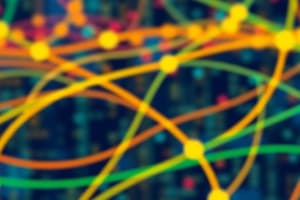Podcast
Questions and Answers
What is the main method to counteract attenuation in a communication pathway?
What is the main method to counteract attenuation in a communication pathway?
- Boosting the signal's strength with amplifiers (correct)
- Minimizing the effects of jitter
- Using error correcting codes
- Implementing fast protocols
Which factor contributes to interference in communication devices sharing the same frequency bandwidth?
Which factor contributes to interference in communication devices sharing the same frequency bandwidth?
- Competing for access to the available signal (correct)
- Propagation delays
- Distance
- Resistance
What does jitter refer to in data transmission?
What does jitter refer to in data transmission?
- Amount of time data takes to traverse a link
- Delay of data due to slow media types
- Boosting the signal's strength
- Variation in arrival times of packets (correct)
How can delay be mitigated in a network?
How can delay be mitigated in a network?
What results from the loss of energy in light passing through glass windows?
What results from the loss of energy in light passing through glass windows?
What is noise in the context of data communications?
What is noise in the context of data communications?
How does attenuation impact signals in data communication?
How does attenuation impact signals in data communication?
Which of the following is used to combat noise in data communications?
Which of the following is used to combat noise in data communications?
What is interference in the context of data communications?
What is interference in the context of data communications?
How does jitter impact data communication?
How does jitter impact data communication?
Flashcards are hidden until you start studying
Study Notes
Data Communications Impairments
Data communication systems transmit information between two or more parties over various channels such as telephone lines, wireless networks, or fiber optic cables. Despite advances in technology, these transmissions can sometimes suffer from impairments that degrade their quality and reduce efficiency. In this context, we'll examine some of the common data communications impairments including noise, attenuation, interference, jitter, and delay. Understanding these issues is crucial when designing reliable and efficient communication systems.
Noise
Noise refers to any unwanted signal added to the desired transmission during its journey across the channel. It can originate from various sources like radio waves, cosmic rays, natural electrical activity within the earth itself, electromagnetic radiation emitted by high voltage power lines, etc.. This additional signal competes with the intended message, making it harder for the recipient to discern the actual transmitted data. Overcoming noise is critical for successful communication because it directly affects the integrity of the received message. Techniques used to combat noise include error correction codes, forward error control coding, and signal processing techniques.
Attenuation
Attenuation is the reduction of amplitude (or strength) of signals due to absorption or scattering while traveling through a medium. Common examples include the loss of energy in light passing through glass windows, or sound being absorbed by walls. As signals travel along a communication pathway, they weaken gradually due to factors such as resistance, distance, and frequency. To counteract attenuation, amplifiers may boost the signal's strength before it reaches its destination.
Interference
Interference occurs when multiple communication devices share the same frequency bandwidth and compete for access to the available signal. For example, if several radios operate simultaneously near each other without coordination, interference will occur which could render none of them usable until one stops transmitting. Mitigating interference typically involves assigning unique frequencies to different users or employing methods like time division multiplexing where only one user talks at once and switches off periodically so others have a chance to speak(5).
Jitter
Jitter is the variation in arrival times of packets belonging to the same stream of data arriving at the receiver. This variability results from differences in propagation delays experienced by individual data units. These variances cause out-of-order packet delivery and contribute to service degradation. Buffering and smoothing algorithms help in minimizing the effects of jitter.
Delay
Delay refers to the amount of time it takes for data to traverse a particular link in the network. Delays can arise from various causes—for instance, data must wait its turn if multiple messages need to pass through a shared resource; there might also be queuing delays due to congestion, or transmission delays caused by slow media types like dial-up connections. While some delayed signals can eventually arrive intact, excessive delay often leads to retransmissions which further compound the problem. Strategies to mitigate delay involve implementing fast protocols, improving hardware components speed, and optimizing routing procedures.
In summary, understanding and managing these impairments play crucial roles in ensuring effective transmission of data over communication channels. By combatting noise using error correcting codes, addressing attenuation via amplification, controlling interference with appropriate sharing mechanisms, reducing jitter by buffering or smoothing techniques, and handling delay through faster processes or improved infrastructure, better communication performance can be achieved.
Studying That Suits You
Use AI to generate personalized quizzes and flashcards to suit your learning preferences.




